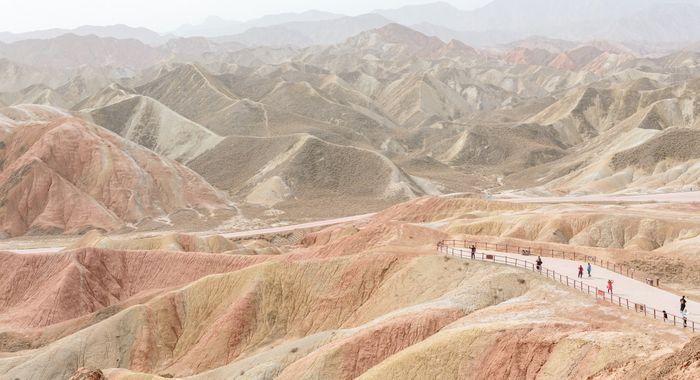Journalism // Go to the Mountain (SUITCASE Magazine Vol. 24)
I collaborated with the Japanese tour operator wondertrunk & co to organise a trip to the Japanese region of Shonai, a rural province known for both its farming and the ongoing practice of Shugendo, an ancient form of folk religion. Alongside the photographer Aron Klein, over ten days I visited farm restaurants, temples and pilgrim lodges before joining the mischievous Master Hoshino, the moon-bearded mountain master who guided us through a three-day Shugendo experience involving fasting, hiking and praying on the sacred Dewa Sanzan mountains. The final article was published in the autumn 2018 issue of SUITCASE Magazine, The Slow Issue. You can read the piece in full here: https://suitcasemag.com/articles/pilgrimage-shonai-japan
"HUARGH, HUARGH!"
As our motley band of pilgrims thrusts our arms back and forth in unison in a move more naturally associated with drunk dads at weddings, I have what can only be described as a momentary out-of-body experience. I'm balanced on a rock in the middle of the Japanese forest, the lone woman surrounded by men dressed in nothing but loincloths.
In front me is our leader, a tiny force of nature topped with a moon-white beard, while the man we've nicknamed "the Spartan" - a six-foot-six, tattooed CrossFit trainer - towers over me to my left. Our chants ring into the trees as we prepare to step under a waterfall and purify ourselves, the first stage in our quest to be reborn. It's a spectacularly weird moment, and one that only makes sense in the context of the previous few days of mental, physical and spiritual preparation in the northern region of Shōnai.
As we tuck into shards of bamboo shoots festooned with tiny sardines, shiny slices of mackerel balanced atop golden root vegetables and miniature clusters of mushrooms, Mitsu tells me how she believes we should eat seasonally and locally to maintain our health. "Globalisation means that we are losing the idea of local flavours. I don't use medicine - I eat what I grow on the farm and forage from the mountains, whether that's bitter spring herbs to detox or cool summer melon to regulate body temperature." I smile as I think about how this powerhouse grandmother has been quietly practising terms like farm-to-table and foraging long before they became foodie buzzwords.
I later meet Daizaburo Sakamoto, a manga illustrator turned professional Yamabushi. With his man bun, MacBook and loose linens, he looks like the ultimate hipster - an impression that only intensifies when I learn that he made his backpack out of animal hide and forges his own steel knives from iron-ore dust. Daizaburo moved here from Tokyo and began gathering mountain survival techniques into material for a best-selling book.
"Human life used to be indistinguishable from nature," he tells me, "but today it has become so developed that we don't need nature to survive. The perception of culture in cities is spread so thin that you can barely feel it, whereas in the mountain it has evolved vertically - it's deep-rooted. When we reconnect with these ancient cultures, we can rediscover who we are."
Cut to me standing in front of the waterfall, where unfortunately it seems there's a ladies-first policy. Master Hoshino beckons and I nervously wobble over the rocks on my dodgy ankle and duck under the ice-cold stream. We've been given a shortened version of a heart sutra (prayer) to recite, but as soon as the water hits my mind goes blank and it's all I can do to stop myself from squawking and flapping like the drenched goose I must resemble. Emerging a few moments later, however, I feel strangely refreshed, and Master Hoshino later tells me that it's here he feels a shift in me from fear to acceptance.
After a quick break back at the lodge - in which I'm told no for reading as it takes me out of the present moment - we follow up a session of meditation with a night walk. Fortunately it's a full moon and the way is bright, but I still can't help stabbing the stone- studded ground with my walking stick and frantically waving my lantern. The Master walks ahead, his ghostly form shimmering dustily in the darkness, until we reach a bridge from which we can hear the river roar and fireflies blink on and off. It's a lesson in trusting your senses and from this point on I give in more readily to the path, the meditative pace of putting one foot in front of the other lulling me into a state of peace.
Before we leave Master Hoshino takes us to the ocean for a final meditation, although the waves stirred up by the previous day's downpour are a little too savage for true reflection. As I'm slapped repeatedly in the face by spray and swallow lungfuls of salty water, I spot Master Hoshino gleefully bobbing up and down, laughing, before he disappears off into the distance.
Clambering up to a nearby lighthouse, I sit and gaze across the sea back towards the West. It would be wrong to say that I feel like a different person entirely, but I do feel a certain sense of calm, trust in my intuition and acceptance that I definitely didn't possess before. "Uketamo," I think, as I stare across the water, towards home.

